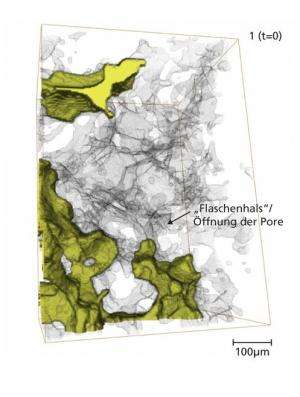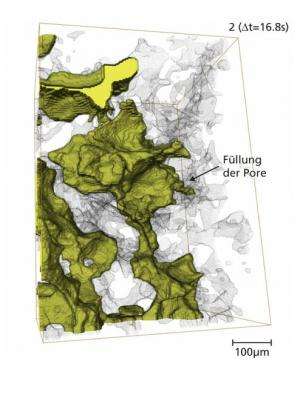Computed tomography provides real-time 3-D pictures showing how oil and water flow in porous rock

For the first time, experiments using computed tomography have allowed scientists to observe in 3D the flow of oil and water in real rock on an unprecedented scale. The new approach trailed and the information gathered by the experiments contribute to an improved understanding of multiphase flow and transport in porous media. The research was performed by a joint team of scientists from Shell, the Paul Scherrer Institute in Switzerland and the Johannes Gutenberg University in Germany. The results have been published in the Proceedings of the National Academy of Sciences.
On a global scale conventional oil production leaves approximately 50-70% of the oil behind. With this new insight into the fundamental processes the industry can develop new and safe methods to produce more oil from existing reservoirs. Oil and gas are typically trapped inside small pores in sedimentary rocks. Standard approaches for describing macroscopic behaviour of simultaneous flow of several immiscible fluids, such as oil and water have many shortcomings and do not contribute to our understanding of the processes on the level of single pores. The new experimental data provide a ground-breaking reference to validate pore-scale numerical models with individual pores at a spatial resolution of a few thousandths of millimetres. The experiments have been performed at the Swiss Light Source at the Paul Scherrer Institute and are based on a new fast computed tomography (CT) technique for 3D visualisation of the processes as they happen. In these experiments small samples of the rock are illuminated from different directions with high intensity X-rays, and the images produced are combined to provide high resolution 3D images that can be put together to create a movie showing the processes.
Sarah Irvine, the supporting scientist at the Paul Scherrer Institute, who helped develop the fast tomography technique and execute the experiment, said: "In the past, full CT scans at this spatial resolution would have taken 20 minutes or longer. Using X-rays from the SLS with our fast tomography setup, we can acquire individual projection images in a few milliseconds or less. Typically over a thousand of these acquired over 180° of rotation are combined to reconstruct a full 3D data set with a total scan time of just a few seconds, or even faster".

Michael Kersten of the Institute of Geosciences at Johannes Gutenberg University in Mainz, Germany, said: "This achievement is important to understand how a mixture of several fluids flows through pores of different sizes". The Mainz researchers contributed primarily to the data analysis and visualisation. Thanks to their software skills and experience gained over a decade of CT work, Kersten's group was able to reduce over 10 TB of high-resolution data down to minute-lasting movies of the key events. The results shed light onto characteristics of fluid-behaviour that up till now were only poorly understood. For the first time ever, the researchers were able to directly observe so-called Haines jumps, sudden changes in the way a fluid moves through porous media, in actual rock. The findings oppose the common paradigm that such changes are locally restricted to single pores. Instead, they cascade through dozens of pores simultaneously.
Steffen Berg, research institute member of Shell Global Solutions International B.V. at Rijswijk, The Netherlands, said: "This work has the potential to change how we look at the mechanisms in porous media and apply this improved understanding to solve some of the energy industry's greatest challenges. The new quantitative data helps to build and validate computer models used to describe the flow of fluids in porous rock. It enables us to ultimately predict macroscopic behaviour and to optimise enhanced oil recovery techniques accordingly".
More information:
Berg, S. et al. Real-time 3D imaging of Haines jumps in porous media flow, Proceedings of the National Academy of Sciences.
Published online before print February 19, 2013, DOI: 10.1073/pnas.1221373110
Journal information: Proceedings of the National Academy of Sciences
Provided by Paul Scherrer Institute




















